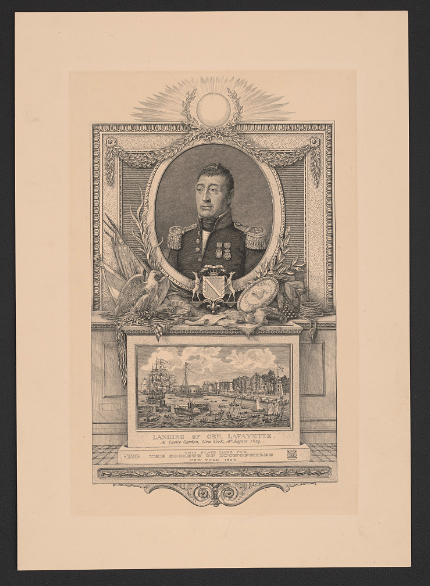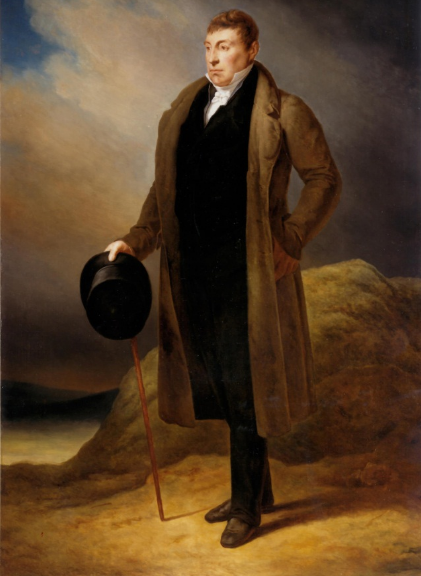Departing from France in July of 1824, the Marquis de Lafayette embarked on his expansive tour of the United States at the invitation of President James Monroe. Over the next sixteen months, he traveled across twenty-four states using improved infrastructure for stagecoach travel and technology such as steamboats and canals, but also on horseback. While he was hosted and joined by friends throughout the tour, for its entirety he was accompanied by his son, Georges Washington Lafayette, and his secretary, Auguste Levasseur, who published a book about their travels in 1829. Lafayette received a hero’s welcome, including parades, balls, dinners, and commemorations in his honor, which resulted in monuments, streets, and squares being dedicated in his name throughout the country. Often, these featured military demonstrations. He attended numerous anniversary events marking the American Revolution, often speaking with friends from the Revolution, politicians, and surviving veterans.
Lafayette Arrives to America
Lafayette arrived to American on the ship Cadmus, landing in Staten Island on August 14, 1824, greeted by a welcoming parade in New York City attended by up to two-thirds of the city. That evening, a reception in his honor was hosted by the Society of the Cincinnati. Unable to attend celebrations, former President John Adams wrote to Lafayette, “There is not a man in America who more sincerely rejoices in your happiness and in the burst of joy which your presence has diffused through this whole continent than myself,” and invited him to visit him in Quincy, Massachusetts outside of Boston.1 Lafayette obliged.
From there, he continued to tour parts of New England such as Connecticut, Rhode Island, and New Hampshire. He stopped at locations significant to the American Revolution such as Lexington and Concord and Boston. On September 8, he returned to New York City to visit Fort Diamond, renamed Fort Lafayette, in his honor, and continued public celebrations. While in the city, he commemorated the forty-seventh anniversary of the Battle of Brandywine on September 11 with French residents, before proceeding on a trip up the Hudson River.
After traveling through New York and New Jersey, Lafayette was greeted by a parade and celebrations in Philadelphia on September 28, and then proceeded to Delaware in the following week. On October 27, he arrived Baltimore by the steamboat United States, visiting sites such as Fort McHenry. From there, he proceeded to the capital region.

Lafayette in the Capital Region and Virginia
On October 12, Lafayette arrived in Washington, D.C., greeted by ceremonies, celebrations, and dinners. The capital region was where he spent the most time on his American tour, as he would return again in August of 1825 at the end of his tour. While in Washington, D.C., the party visited with surviving members of the Custis family, as Georges spent two years with the Washingtons and Washington’s step-grandchildren during the French Revolution while his father was imprisoned.
Within a few days of their arrival, the party visited Martha Parke Custis Peter and her husband Thomas Peter at their residence in Georgetown. The following day they convened at Arlington House to dine with the extended Custis family, including George Washington Parke Custis. While at Arlington House, Lafayette connected with Phillip Lee, an enslaved valet, and nephew of William Lee, who served as Washington’s valet in the Revolution. Next, they visited Alexandria, celebrating its connection to Washington and socializing with John Quincy Adams, who was then serving as secretary of state.
On October 17, Lafayette paid his respects at the tomb of his mentor, George Washington, at Mount Vernon arriving by the steamship Petersburg. Levasseur described Lafayette’s reaction to the tomb, writing he exited the vault with his “eyes overflowing with tears” and that the party “resembled a bereaved family.”2 Georges remarked that the house appeared as when he last visited it, and showed his father the Bastille Key. George Washington Parke Custis presented Lafayette with a ring containing Washington’s hair, customary for mourning jewelry of the time period.3
In the following days, he visited the Yorktown battlefield on the forty-third anniversary of British surrender. There, Lafayette recalled to guests about his experiences on the battle field with Rochambeau, Baron de Vioménil, and Washington. After the commemorations, the party travelled to Richmond, Williamsburg, and Hampton Roads. The party commented on the “severe labor” of those enslaved in the region.4 Afterwards, Lafayette remained in the capital region, Virginia, and Maryland through most of February of 1825.
During this time, he socialized with his friends from the American Revolution. He visited former presidents Thomas Jefferson and James Madison at their respective homes. Jefferson wrote Lafayette before his arrival, revealing his excitement to “trace it thro’ all the disastrous chapters of Robespierre, Barras, Bonaparte, and the Bourbons! these things however are for our meeting.”5
While in Washington, D.C., Lafayette made multiple visits to Congress, and became the first foreign dignity to address the body. In his brief speech on December 10, he expressed thanks for his welcome, sharing, “My obligations to the United States, sir, far exceed any merit I might claim. They date from the time when I have had the happiness to be adopted as a young soldier, a favored son of America.”6 Weeks later Congress awarded him a grant for his service in the American Revolution, and Lafayette presented them with his portrait before continuing with his tour.

Lafayette's Tour of the South and West
Lafayette’s tour continued south through Virginia to North Carolina. On March 4, he visited Fayetteville, North Carolina, which was named in his honor. He proceeded to South Carolina, making a stop in Camden to rededicate the Baron de Kalb’s grave before proceeding to the capital, Columbia, and arriving in Charleston on 15 March. While there he was hosted by his friend Benjamin Huger and his son, Francis Kinloch Huger, who attempted to rescue him from prison during the French Revolution.
On March 19, he arrived in Savannah, Georgia, and laid the cornerstone of a monument dedicated to Nathanael Greene. Then, he traveled along the Augusta River by steamboat as he proceeded through the rest of the state before traversing it by land. Lafayette arrived in Alabama on March 31 after crossing the Chattahoochee River and being escorted through Creek territory. While in Alabama, he visited various cities before travelling by steamboat to Mobile Bay to enter Louisiana on April 9. To get to New Orleans, he ferried on the steamer Natchez on the Mississippi River, the vessel was fit with accommodations such as a chef and fine furnishings. After his visit in New Orleans, he again boarded the steamer to travel along the river to Natchez, Mississippi and St. Louis, Missouri.
Lafayette arrived to the former French capital of Upper Louisiana, Kaskaskia, Illinois on April 30, greeted by various French officials and American politicians including William Stephen Hamilton, the son of Alexander Hamilton. In the following days he proceeded to Nashville and attended a celebration hosted by future president Andrew Jackson.
Lafayette and his party faced the largest challenge of their journey when the steamboat Mechanic sunk on the Ohio River near Louisville, Kentucky the night of May 8. While physically unharmed, the party lost clothing and items collected throughout their journey as well as money. They could not travel further into northern Ohio. However, they continued their journey to Indiana and Kentucky. On May 19, Lafayette arrived in Cincinnati, Ohio, visiting various cities on the border of Ohio, Kentucky, and present-day West Virginia in the following days.
Lafayette Returns North
As Lafayette continued towards the northeast, he returned to Pennsylvania in route to northern New York state. While in New York, he travelled along parts of the uncompleted Erie Canal, visiting Buffalo and Niagara Falls. Afterwards, he returned to New England to honor the fiftieth anniversary of the Battle of Bunker Hill on June 17 with a monument in Boston alongside Daniel Webster with a crowd up to 30,000 spectators.7
Later that month he completed his tour of New England, visiting Maine on June 23 and Vermont on June 28. On July 2, he visited West Point, and finally to New York City for Fourth of July celebrations honoring the signing of the Declaration of Independence. They continued through New Jersey, Pennsylvania, and Delaware, stopping in Philadelphia for a second time from July 16 to July 25. At the end of the month, Lafayette proceeded to Baltimore to finish his tour in the capital region.
Lafayette Returns to the Capital Region
On August 1, 1825, Lafayette returned to Washington, D.C. for the final leg of his tour. He continued to visit friends such as James Monroe and Thomas Jefferson, as well as attend social invitations throughout the area to commemorate his tour. For his sixty-eighth birthday, Lafayette was honored with a state dinner at the White House overseen by President John Quincy Adams. Levasseur recorded Adams toasted to not only Lafayette’s birthday, but Washington’s as well, which Lafayette believed to be a great tribute.8 The following day, Lafayette departed Washington by steamboat and made his final stop at Mount Vernon. On September 9, he transferred to the frigate USS Brandywine, and then sailed back home to France.
The Legacy of the Lafayette’s Tour
During his American tour, Lafayette experienced the changes in the United States in early nineteenth century, including the physical expansion of the country. Levasseur’s documentation of their travels provides first hand accounts of the transformation of the United States after almost fifty years as a nation. Their travel was made possible through increasingly more effective transportation connecting the states, particularly through riparian means, or travel facilitated on river systems.
Lafayette’s tour overlapped with early anniversaries of the American Revolution, heightening the importance of his role in American history. Additionally, the celebration of his accomplishments warmed previous tensions towards France after events such as the XYZ Affair, the Genet Affair, and the Quasi War. While visiting, Lafayette’s memory of Washington as a father-figure, as well as his son’s, was emphasized by their multiple visits to Mount Vernon and ongoing connection to the Custis and Washington families.
Zoie Horecny, Ph.D.
Notes:
1. “From John Adams to Marie-Joseph-Paul-Yves-Roch-Gilbert du Motier, marquis de Lafayette, 22 August 1824,” Founders Online, National Archives.
2. Auguste Levasseur, Lafayette in American in 1824 and 1825 Or, Journal of Travels in the United States, (White, Gallaher, and White, 1829), 181-182.
3. Auguste Levasseur, Lafayette in American in 1824 and 1825 Or, Journal of Travels in the United States, 181-182.
4. Auguste Levasseur, Lafayette in American in 1824 and 1825 Or, Journal of Travels in the United States, 196.
5. “From Thomas Jefferson to Marie-Joseph-Paul-Yves-Roch-Gilbert du Motier, marquis de Lafayette, 9 October 1824,” Founders Online, National Archives.
6. Lafayette to Congress, 10 December 1824, Register of Debates in Congress, 1:4
7. Auguste Levasseur, 226.
8. Auguste Levasseur, 271.
Bibliography:
Auricchio, Laura. The Marquis: Lafayette Reconsidered. New York: Alfred A. Knopf, 2014.
Gottschalk, Louis. Lafayette Comes to America. University of Chicago, 1935.
Idzerda, Stanley J., Anne C. Loveland, and Marc H. Miller. Lafayette, Hero of Two Worlds: The Art and Pageantry of His Farewell Tour of America, 1824-1825. University Press of New England, 1989.
Reese, Elizabeth. Marquis de Lafayette Returns: A Tour of American’s National Capital Region. Charleston: The History Press, 2024.
Unger, Harlow Giles. Lafayette. John Wiley & Sons Inc., 2002.
Vowell, Sarah. Lafayette in the Somewhat United States. New York: Riverhead Books, 2015.
